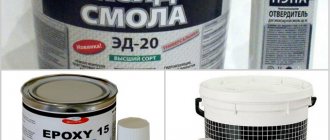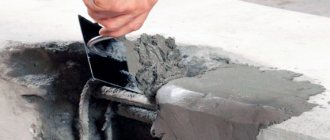If we consider the road surface system as a living organism, then cracks in the asphalt will act as foci of infection, which, without proper “treatment,” will slowly begin to undermine the entire organism and deplete more and more of its resources. As you know, roads are one of the “hot” three most pressing Russian problems. Its source in 90% of cases lies in poor service, poor quality and untimely repairs. As people say, “The miser pays twice.” So it turns out that in the pursuit of savings, roads patched ten times over, like a poor man’s bag, are destroyed, and in the end, repairs of cracks in the asphalt pavement are still required, which is much more expensive than partial repairs, but done on time. Let's talk in more detail about the causes of cracks and how to repair cracks in asphalt.
Types of cracks
There are three types of cracks:
- longitudinal,
- transverse,
- mesh.
The latter arise due to exposure to aggressive environmental conditions. This low level of pavement protection from the elements is usually caused by long-term use of asphalt and its “aging”. “Old” asphalt becomes covered with them in the same way as the skin of an aged person becomes covered with wrinkles.
Often, longitudinal cracks do not appear one at a time; they quickly find a “mate” and spread across the surface, like an infection.
Quite often, such cobwebs form on personal plots and in asphalted courtyards of private houses. Here the reason is completely different: the asphalt is not subject to the loads necessary to maintain its “elasticity”. Accordingly, the coating, without use, begins to “decrepit” in the literal sense of the word. The occurrence of longitudinal cracks is usually caused by violations of the manufacturing technology of the top layer of asphalt concrete mixture or its improper filling.
Constant temperature changes only aggravate the situation and turn repairmen’s mistakes into a real disaster. A large network of intricate interweavings of longitudinal and transverse cracks arises due to a combination of negative factors. Edge straight or crescent-shaped cracks along the side of the road occur due to the delamination of a certain part of the asphalt. The reason may be ground movement, shrinkage, or improper repairs in which the new coating was laid with errors.
Advice: to avoid such “asphalt disease” you need to use only high-quality materials and take into account all the nuances of the pavement laying process.
Why is it important to seal cracks?
Cracks will inevitably form on the surface of an asphalt concrete pavement, especially one that has already had a decent service life. Cracks can look different: in the form of long longitudinal or transverse strips of various lengths, crossing the entire width of the pavement, or in the form of a grid in individual areas. Unlike potholes and cracks practically do not interfere with the normal movement of traffic, their width is no more than 2-5 millimeters. When the equipment moves, they cannot damage the suspension. When driving through a crack (even one located across the road), you may not notice the swaying. But it is still necessary to repair cracks, as they shorten the life of the road.
Causes of cracks in asphalt concrete
The causes of cracks may be:
- Poor quality construction of the base for the upper layers of road pavement.
- Subsidence of soil layers below the trough (due to leaching, periodic freeze-thaw cycles).
- The use of several types of asphalt concrete, or a mixture of the same recipe, but with different physical and mechanical properties, fillers, on one section of the roadway. In this case, destruction occurs due to different coefficients of thermal expansion.
- The movement of equipment with an axle load that is more than permissible for a given road design (the one that was taken for calculations during the design).
- Poor quality of joints between asphalt concrete areas that are not laid continuously (between grips). Such cracks occur especially often if the width of the road is greater than the width of the asphalt paver and the work is carried out in several passes.
- Poor quality sealing of joints when carrying out patching repairs and sealing control cuttings.
- Pressure on the asphalt from below from the roots of plants growing in the right-of-way.
- Loss of elasticity (flexibility) of the binder material, its burnout as a result of heating in the hot season.
The width of the cracks is no more than 2-5 millimeters, so, unlike potholes, they practically do not interfere with the normal movement of traffic. But their repair is necessary, since over time the crack can expand.
What can cracks lead to?
An unsealed crack in an asphalt concrete pavement will inevitably expand. As practice shows, even a small defect about a millimeter wide turns into a wide pothole after a few months. Even if the crack crossed only one top layer of road pavement (according to the rules, asphalt concrete is laid in several layers), the destruction spreads deeper and leads to damage even to the lower layers, which previously remained intact. This is a consequence of a number of factors:
- Moisture accumulates through the crack, not only under the influence of gravity (this is true for widespread damage), but also due to the capillary effect. The latter manifests itself in small defects, almost invisible to the naked eye.
- When water gets into a crack and freezes, it turns into ice, which has a larger volume than water. Inevitable expansion leads to the destruction of asphalt concrete. If the road is treated with anti-icing agents (salt), then freeze-thaw cycles occur even without the obligatory condition of heating the road surface to a temperature above zero degrees Celsius. As can be seen from observations, asphalt concrete is destroyed most of all in winter. Moisture easily penetrates into the space between the layers of asphalt, especially if the bitumen or emulsion was applied poorly during installation. One small crack can cause destruction of the pavement over a large area of the road surface.
- Ice also puts pressure on the underlying asphalt concrete mass. Pressure promotes the formation of microcracks, which, accumulating water, begin to work towards destruction.
- It is important to seal cracks before the start of the warm season. At this time, the development of defects on asphalt is not so intense, but still occurs. This is due to the fact that dust and soil accumulate in the cracks, which may contain plant seeds. When they grow with their roots, they also exert pressure on the asphalt. This leads to the expansion of defects and destruction of the road pavement. This is especially noticeable in areas where there is no heavy traffic.
What causes cracks in asphalt?
The reason for such a defect may lie in an error made at any stage of road construction. Moreover, the earlier a mistake was made in the process, the more difficult it will be to locally eliminate its consequences.
- Incorrectly conducted geological exploration. Before laying a road, the area must be studied by geologists. Particular attention is paid to the soil and its characteristics. Improper soil preparation will result in movement and settlement. Accordingly, the road will “walk” under your feet, and not a single asphalt can withstand this, and it’s good if the matter is limited to only cracks.
- Incorrectly laid foundation. The second stage of construction after exploration and design can also lead to catastrophic consequences. If the wrong slope was chosen or the base was improperly compacted, the coating will certainly settle after a short period of use. The main problem with such a mistake is that even after replacing the old cracked top layer with a new one, no one can guarantee that it will not suffer the same sad fate.
- Failure to comply with the conditions for laying the top layer. The asphalt concrete mixture must be at a certain temperature, unless of course we are talking about the so-called “cold asphalt”. If the temperature of the mixture drops below 120 degrees, then it is a priori considered defective and cannot be used. The temperature regime must be maintained in special “tanks” of equipment for transporting ABS. Their design resembles ordinary household thermoses. In this case, the ambient temperature must also be taken into account: in the cold season it is better to use “cold” asphalt concrete. It will not only “fit” better, but will also protect the base coating from sudden temperature changes. Otherwise, such a patch will become the source of a whole network of cracks later. A poorly prepared base will also have a negative impact on the future fate of such coating. You cannot lay asphalt in the rain. Water in this case is the worst enemy of road surfaces.
- Violations of the ABS “preparation” technology will also affect its quality. All its components must be properly prepared: sand and crushed stone are thoroughly washed, and bitumen and mineral powders are properly selected. Low quality raw materials naturally also cannot become the basis for strong and durable material.
- Freezing of water in the “pores” of asphalt . Hot asphalt concrete pavement, which is used in 90% of domestic roads, has a porous structure. When water stagnates and the temperature then drops to zero, the water in the clogged pores freezes. Everyone knows that the distance between water molecules increases and the pressure with which it seeks “free space” is colossal and can even tear apart metal pipes or stone blocks. Naturally, asphalt cannot withstand such a load.
Advice: in most cases of crack formation, the human factor is to blame. However, although nature does not have bad weather, sometimes it is climatic conditions that cause such a deplorable situation. And even here, quite often the road surface is simply not designed to withstand such aggressive environmental behavior, although it can be “strengthened” and protected properly during road construction.
Asphalt repair technologies
Of course, in the local area it is not as important to seal cracks as, for example, on some highway that passes hundreds of thousands of trucks per day. However, the appearance of the property is the face of each owner. What is the difference between a crack in the asphalt in the yard and a broken tile in the bathroom? That's right, nothing, everything needs repair.
Technology for pothole repair of asphalt point by point: - first, the boundaries of the repair are determined, the perimeter is outlined; — cutting out damaged asphalt pavement; - remove any remaining material; - lay an asphalt concrete mixture (this is a combination of crushed stone, sand, refractory bitumen and mineral powders, which is available in stores); - level and compact the coating.
The technology of infrared asphalt repair deserves special attention. This innovative solution leaves behind traditional methods of restoring this coating. There is no noise when removing damaged asphalt, the work is carried out without restricting traffic – these are just some of the advantages of the method.
The use of infrared radiation (invisible to the human eye, by the way) allows you to heat the road surface from the inside without affecting the upper layers. In addition, this is a more economical method when comparing energy costs. No additional milling equipment is required during repairs. Loosening of heated asphalt is carried out using improvised tools. As a result, we get no seams and fewer operations to eliminate the defect. And less asphalt concrete is added.
What methods can be used to repair cracks in asphalt pavement?
Pit method
The most common method of repairing roads with cracks is patching. Before repairing cracks in the asphalt pavement, it is prepared: defective areas are outlined. Pieces of asphalt are cut out with a special cutter, and it is important to touch not only the upper, but also the lower layers. The bottom of the resulting pit is thoroughly cleaned of crumbs, dust and debris. Then it is filled with hot bitumen emulsion and the asphalt concrete mixture is laid on top. Next, the area is compacted using manual vibrating plates.
Read on topic: How to get a road repaired
This type of repair is considered the most common and cheapest. The only drawback of the technology is that pothole repair does not ensure sealing of the coating.
Jet-injection method
This method is cheap, but it is selective and is suitable only for those sections of the road that are not subject to heavy loads. Cracks are cleaned using a special device that pumps compressed air. Then the inner surface of the defect is treated with bitumen emulsion and filled with crushed stone. For fixing, crushed stone is also “impregnated” with the emulsion and compacted. The measure, of course, is quick and convenient, but is considered only as a temporary one, since after a certain period the cracks will still make themselves felt.
Method using cast asphalt concrete
The stage of preparing the coating for repair work is exactly the same as for simple pothole repair. The only difference: if there is a recycler, the removed layer of asphalt is recycled and reused. They fill the hole with it, compact it and pour cast asphalt concrete mixture on top. There is no need to compact this material. If the repair is carried out on a dangerous section of the road, to increase the adhesion of the patch to the tires, it is immediately sprinkled with black crushed stone and pressed into the coating.
Filling cracks with various types of polymers
The method is very effective: cleaned cracks are hermetically sealed with a special compound that will no longer allow water to pass through and will prevent further destruction of the coating, but such materials are usually expensive, so not every utility office can afford such a luxury.
Advice: any of the above methods can temporarily or permanently correct flaws in the top layer of the road surface, but are completely powerless in the case of foundation laying errors or soil defects. Only complete repair of the road surface and its replacement will help here.
What materials are needed to repair cracks?
Various materials are used to repair cracks in asphalt pavement:
- Asphalt concrete mixtures (filling and binding, cold and hot, etc.);
- Bitumen – its advantages include low price and high strength. But in order for the repair of cracks with bitumen to be of high quality, it is necessary to heat it to a high temperature, and in addition, dry the crack well;
- Emulsions (they do not need to be heated; in addition, emulsions are not afraid of moisture and have low viscosity - which means they fill the crack well). Emulsions are usually made from bitumen;
- Sealants are the most suitable material for eliminating defects, because they have optimal viscosity and moisture resistance parameters. However, sealants have a high cost, and therefore are used to a limited extent, in the most critical areas of the road surface;
- Sand is an inexpensive material necessary to protect the fault from excessive heating in the heat. In addition, sand effectively prevents the upper sticky layer of bitumen, emulsion or sealant that fills the crack from sticking to the wheels of cars.
Afterword
As an additional measure, a wear layer is also applied to the top main layer of asphalt using casting technology, which performs the protective function of the coating. It is precisely capable of providing sealing and preventing water from entering the asphalt “pores”. This addition is optimal for those types of repairs that cannot hermetically “clog” the crack. By the way, not all types of cracks can be repaired locally.
Read on topic: Geosynthetic materials for road construction
The “mesh” on old asphalt cannot be “treated” by any of the above methods; it can only be removed along with the coating, replacing it with a completely new one. It’s exactly the same story with crescent-shaped cracks and defects “along the edge” at the very curb. Here we are talking about tearing one layer of coating from another, and pouring polymer or applying a patch in this situation is the same as “poulticing a dead person,” as our people say. You should treat cracks as the first warning signs of a “disease” and quickly get rid of them, so that you don’t have to spend your entire budget on “treating” seriously damaged asphalt.
Cracks in asphalt repair without cutting
BORNIT - Rissflex does not require preliminary cutting and cleaning of the crack. With the help of Rissflex sealant, sealing cracks in asphalt is simplified and cheaper. The sealant (mastic for cold cracks) is simply applied to an unprepared crack and smoothed with a corner.
Video from YouTubeAlternative player
Look
However, in order to ensure high quality filling of cracks on asphalt and based on your own experience, it is better to follow the following recommendations:
- The width of the repaired crack is no more than 1 cm.
- The weather when sealing cracks in asphalt should be warm and windy (from +5 and above). There should be no rain in the near future (4-6 hours).
- The surface of the crack on the asphalt must be dry (a wet crack is allowed, but without water standing in it - in this case, the sealant will take longer to dry).
- It is advisable to clean the crack on the asphalt as much as possible with a brush or a hard broom to remove soil and debris that has accumulated in it and blow it out (for example, with a garden leaf blower). Otherwise, when repairing cracks on the asphalt, dust and dirt will worsen the adhesion of the sealant.
Cold BORNIT-Rissflex sealant is poured into the prepared crack on the asphalt with a small “slide” and leveled with a corner. By the way, this method, with a corner, applies to cases when you need to repair cracks in the asphalt with your own hands. For larger-scale and/or periodic work, semi- or professional equipment is needed, but more on that below.
If the crack in the asphalt is deep, within a few minutes the sealant will flow into it. A depression will appear on the surface of the crack sealed with sealant. In this case, you will need to add crack sealant (crack mastic) and smooth it again with a corner. Do not delay this process, as the sealant dries and a film forms on the surface. By repeatedly leveling the sealant with a corner, you will scrape off this film and although this will not affect the quality of the seam, the seam will look less aesthetically pleasing.
Rissflex crack sealant will dry depending on weather conditions and the size of the crack from 2 hours to a day. Moreover, inside a crack on the asphalt it can dry for up to several days. Dry, windy weather will speed up the drying time of the sealant. First, a thin film forms on its surface (tack-resistant), then the edges dry out and although it is still damp inside the crack on the asphalt, the sealant is no longer afraid of rain.
If for some reason it is impossible to close the repair area to traffic for a long time, you can sprinkle freshly applied BORNIT - Rissflex sealant on top thickly with granite chips (3-10 mm). Granite chips, due to their size, will allow car wheels to pass over uncured sealant without “spreading” it. In addition, granite chips pressed into the sealant and frozen in it will ensure the strength and roughness of the coating. In this case, traffic can be opened after about 30 minutes.










